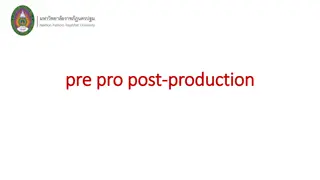Advanced Flower Production Techniques in a Nursery Environment
Explore the concept of flower cultivars, propagation techniques, and control measures for pests and diseases affecting flowers. Learn about the economic importance of cultivars in the flower market and the significance of quality factors in post-harvest flower longevity. Discover different propagation techniques including stem and leaf cuttings for flower production.
Download Presentation

Please find below an Image/Link to download the presentation.
The content on the website is provided AS IS for your information and personal use only. It may not be sold, licensed, or shared on other websites without obtaining consent from the author. Download presentation by click this link. If you encounter any issues during the download, it is possible that the publisher has removed the file from their server.
E N D
Presentation Transcript
SEFIKENG CAMPUS Flower Production in a Nursery Environment Advanced Plant Production Level 4 TOPIC 2: FLOWER PRODUCTION SO 2.0 LO 2.1.1 2.1.5 MR MOTSOETSOE T.E
Lesson Outcomes Students should be able to explain the concept of flower cultivar and give examples. Each cultivar is cultivated according to its economical importance. Relevant propagation techniques will be applied in flower production. Control measures for pest and diseases affecting flowers are identified. Flower production process from planting to wholesaler must be explained.
CULTIVARS (CULTIVATED VARIETY) Is an assembly of plants selected for desirable characteristics that are maintained during propagation.
Lavender twist redbud Lavender twist redbud A cultivar is a plant that is produced and maintained by horticulturists. Example: Lavender twist is a weeping form of redbud, twigs have a slight zigzag pattern Lavender twist is a weeping form of redbud, twigs have a slight zigzag pattern. Although some cultivars occurs in nature as plant mutations, most cultivars are developed by plant breeders and are called hybrids. The first letter of a cultivar is capitalized and the term is never utilized, they are surrounded by single quotation.
The cultivars economical importance Flower market increased emphasis on quality. Quality factors related to post harvest keeping quality including environmental influence on flower longevity, as well as the influence of pathogenic microorganisms such as virus and diseases As competition in the world market increases, quality becomes a more important factor. Increasing vase life of flower life on a pot plant is an important goal.
Propagation techniques used for flower production Stem and section cutting Stem and section cuttings: Stem and section cuttings: There are two types of stem cuttings, tip cutting (flower tip and small portion of stem) and section cutting (include 2 3 inch section of stem). Flowers propagated from stem cutting African violet and section cuttings Helxine (baby s tears). Leaf cuttings: Leaf cuttings: Flowers with soft, fleshy foliage reproduce themselves from leaves. Leaf propagation is faster and reliable. Leaf cutting A healthy leaf with short stem is dipped by the end/tip into a rooting hormone and stuck into a moist propagation media. Flowers such as African violet and Sanseviera.
Leaf Leaf vein vein cuttings cuttings: : 2nd method slash vein of a larger 1st method cut leaf veins into leaf at 1 to 2 inch intervals on the underside of the leaf. Flower sections, then place the bottom of examples such as Rex begonia and the vein pressed into the propagation Smithianthas (temple bells). medium with leaf portion sticking up.
Flower process Flower process Students should remember the nursery operations from previous lesson Students should remember the nursery operations from previous lesson A greenhouse extends the growing season and lets you produce more flower variety In the greenhouse, measures against heat and cold apply to keep winter plants during winter or whenever the weather is not conducive to growing outdoor Some flowers can only be grown in a greenhouse These greenhouse must be equipped with automatic cooling heating and light shade adjustment systems. Irrigation can be manual or automatic Fields are transplanted with greenhouse grown transplants cuttings can also be used Flowers must be planted and raised in beds, furrows depending on cut flowers type. Flowers will have better quality when provided with staking and netting
Flower process (Cont.) Flower process (Cont.) When harvesting, cut flowers quality should be at it peak at the moment of harvesting. Some flowers are picked before opening, others when florets are half or fully open Harvesting is done by hand with sheers or sharp knife to prevent damage and maintain optimum freshness Do not lay flowers on the ground otherwise they may become contaminated by diseases. Immediately after picking, put flowers in water mixed with floral preservative solution and keep in a cool shaded area Flower grading include stem length, straightness and strength, flower size, vase life, lack of defects, maturity, uniformity and foliage quality.
Flower process (Cont.) Flower process (Cont.) Flowers that do not meet quality standard will fetch lower prices and have reduced ability to sell Store flowers in cool temperature to maintain freshness Transportation of flowers to buyers must be in a tempt and humid controlled environment. When harvesting, cut flowers quality should be at it peak at the moment of harvesting. Some flowers are picked before opening, others when florets are half or fully open Harvesting is done by hand with sheers or sharp knife to prevent damage and maintain optimum freshness
Flower process (Cont.) Flower process (Cont.) Do not lay flowers on the ground otherwise they may become contaminated by diseases. Immediately after picking, put flowers in water mixed with floral preservative solution and keep in a cool shaded area Flower grading include stem length, straightness and strength, flower size, vase life, lack of defects, maturity, uniformity and foliage quality. Flowers that do not meet quality standard will fetch lower prices and have reduced ability to sell Store flowers in cool temperature to maintain freshness Transportation of flowers to buyers must be in a tempt and humid controlled environment.
Recap Recap The flower production is explained how it should be applied in the nursery environment. Different kinds of flower cultivar is identified and explained The economic importance of cultivars is explained. Pests and diseases affecting flowers and the control methods are identified.
STUDENT ACTIVITY Explain the best methods to control the following pests and diseases affecting flowers? 1. Major pests . Major pests Lily borers 2. Major diseases Major diseases Mites Brown blight Parasite algae and nematodes Caterpillar Grasshoppers Downy mildew Anthracnose Thrips Leaf rollers Rust Black spot Aphidsa White flies Powdery mildew Botrytis blight Ants Worms Crown gall Bugs Snails Beetle borers Moths























